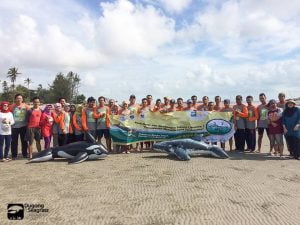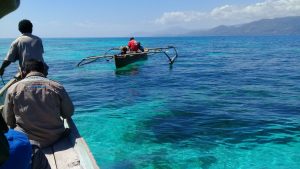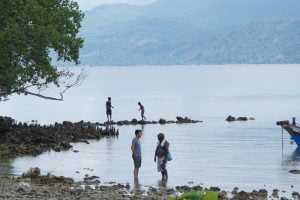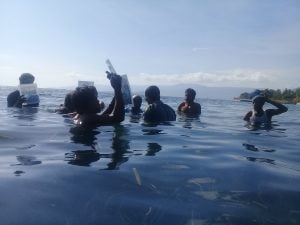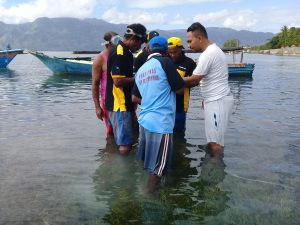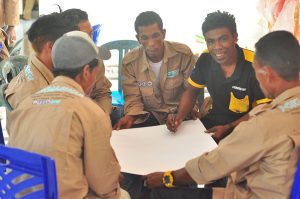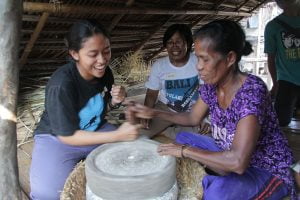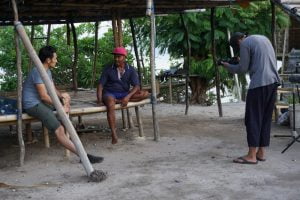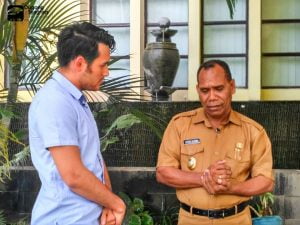Education & Awareness Case Study
The Power of Education and Awareness: Indonesia
A central component of the Dugong and Seagrass Conservation Project is the work done to spread education and awareness of key threats to the species and its habitat, as well as how people’s actions can make a significant difference to their health and conservation. The primary hazards faced by dugongs are anthropogenic – i.e., they are the result of direct or indirect human activity; therefore, understanding the effects we have on the marine environment is an essential first step in securing the future of these unique marine mammals and their habitat.
Governments around the world have begun to recognise the importance of mobilising communities to engage with long-term conservation measures and initiatives that will ensure the ongoing protection of their marine ecosystems and the resources they provide. These resources are vital to sustaining livelihoods in coastal communities and play a key role in helping to mitigate climate change and maintain both marine water quality and biodiversity.
Therefore, our education and awareness projects, such as ID2 in Indonesia, have sought to assist governments in promoting knowledge of dugong and seagrass conservation issues and integrating conservation priorities into national and regional policies and planning.
Four regional project sites were identified in Indonesia under ID2, each of which contained a number of local sites, cumulatively covering 11 villages and a total of 1,104,635.05 hectares of marine territory. Research and awareness activities were conducted throughout these regional sites.
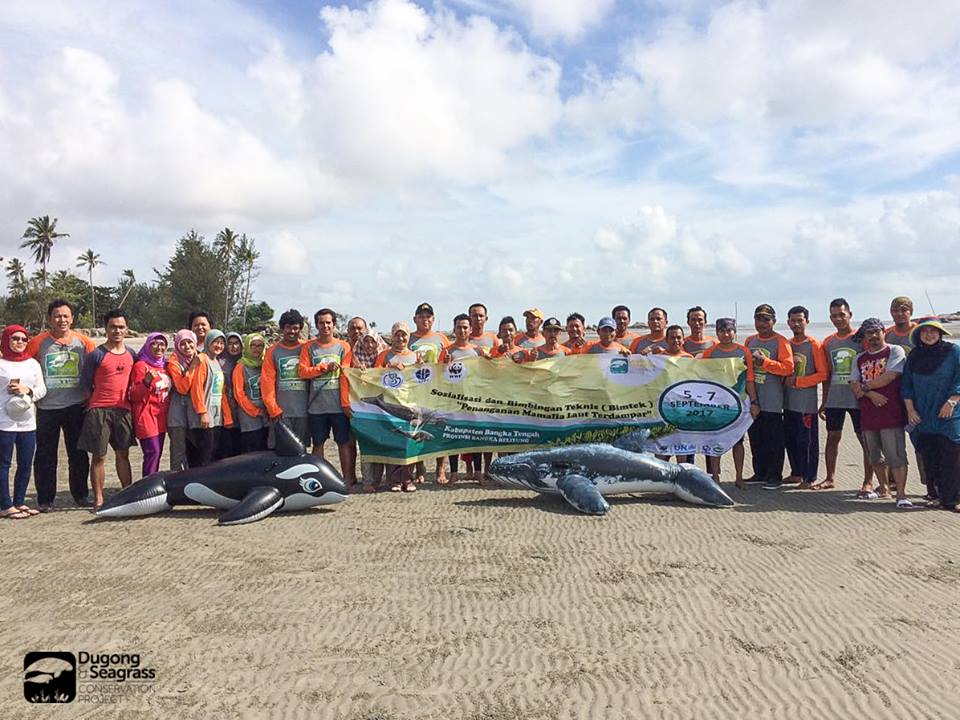
In conservation, awareness is king
Dugongs have been protected in Indonesia since 1999 by Government Regulation No. 7 on “Preserving Flora and Fauna Species”. They are also among the high conservation priority species defined in Ministry of Forestry Regulation No. 57 of 2008 on the “Strategic Direction of National Species Conservation for 2008–2018” and are included in the list of 20 priority species to be managed by the MMAF. These prioritised species were defined in the strategic plan document of the MCB for 2015–2019, and a related document on dugong conservation was prepared in 2012 as part of the implementation of the GEF-funded Trikora Seagrass Demonstration Site Project in Bintan.
Despite these legislative measures, the dugong population has remained in decline; this is assumed to be the consequence of a combination of factors, including low enforcement of legislation to prevent degrading land development, fishing and tourism practices, and the limited awareness and knowledge about the importance of dugongs and their seagrass habitats in Indonesia.
The Project increased substantially the awareness of local communities and society-at-large in Indonesia on the importance of dugongs and their seagrass habitats. The data collected by the surveys was applied across the project’s multi-channel awareness activities.
In this sense, Indonesia is not unique. Across the dugong’s global range, populations have fallen even where legislation does provide for their protection or that of their habitat. Awareness and education are therefore vital in all states that host dugongs and key areas of marine habitat. Hence, the DSCP aims to update existing information on dugong populations, their status and distribution and to identify measures to improve the protection of the species by conducting research, as well as raising awareness and garnering community support.
| ID2 | Project Facts |
|---|---|
| Title: | Improving National Awareness and Research on Dugong and Seagrass in |
| Project Type: | Education and Awareness |
| Project ID | ID2-2102 |
| Objectives | To enhance community awareness regarding dugong and seagrass conservation and management; improve dugong and seagrass research and monitoring capacities; and provide scientific information to support dugong and seagrass conservation and management. |
| Country: | Indonesia. |
| Lead Partner: | Directorate of Marine Conservation and Biodiversity (MCB); Directorate General of Marine Spatial Management – Ministry of Marine Affairs and Fisheries (MMAF). |
| Supporting Partners: | WWF Indonesia; Research Centre for Oceanography, Indonesian Institute of Sciences (RCO–IIS); Faculty of Fisheries and Marine Science, Bogor Agricultural University (FPIK–IPB); Marine Research Centre (MRC); and Yayasan Lamun Indonesia (LAMINA Foundation). |
| Implementation Period: | December 1, 2015–December 31, 2018. |
| GEF Funding: | US$ 335,373.75 |
| Partners' Funding: | in-kind, $4,529,175. |
As is true throughout most of their global range, dugongs in Indonesia are largely threatened by human activity (e.g. incidental catch by local fishing gear, stranding, habitat destruction, destructive fishing practices), while seagrass habitat is most often degraded by coastal development and pollution, such as oil spills and dredging.
These threats can mainly be traced back to the lack of awareness regarding the protected status of, and threats to, dugong and seagrass; it may also have contributed to ongoing local meat consumption and the characterisation of dugongs as commodities or pets.
Four regional project sites were identified in Indonesia under ID2, each of which contained a number of local sites, cumulatively covering 11 villages and a total of 1,104,635.05 hectares of marine territory. Research and awareness activities were conducted throughout these regional sites.
Baseline data on awareness levels, as well as communication strategies at national and project-site levels were required to focus the awareness campaign. The CMS-UNEP questionnaire survey was used to collect this in both online and offline surveys. Offline surveys in project sites in 2016, 2017, and 2018 targeted local people – mainly fishermen aged 18 to 65 years old – whilst a second offline survey in 2018 targeted 1,043 respondents across Indonesia. Online surveys were also conducted at the national level in 2017 and 2018, targeting social media users from various professions and backgrounds aged 18 to 65. The resultant data was used to design creative tools and approaches to reach out to different target groups, including local communities, children, conservationists and decision-makers.
The data were also integrated into databases to support the implementation of a National Plan of Action to protect dugongs and their habitat. These include the IIS Research Centre for Oceanography’s national seagrass database and interactive distribution map (http://gis.oseanografi.lipi.go.id/), a dugong database listing sightings, strandings, live captures and bycatch/entanglement cases that occurred before and during the DSCP implementation in Indonesia (http://db.oseanografi.lipi.go.id/dugong), and an online map showing the distribution of dugong events by location and time (http://db.oseanografi.lipi.go.id/dugong/webgis). (Please note that the links were not functioning properly on 1 May 2019, but the technicians are working diligently on repairing their functionality and we hope to have the database up and running again shortly).
Raising awareness
The Project increased substantially the awareness of local communities and society-at-large in Indonesia on the importance of dugongs and their seagrass habitats. The data collected by the surveys was applied across the project’s multi-channel awareness activities.
National media engagement was used to broadcast information on the status and conservation requirements of dugongs and their seagrass habitat. This covered online social media sites such as Facebook (Dugong and Seagrass Conservation Project Indonesia), Twitter (@dscpindonesia) and Instagram (@dscpindonesia), reaching more than 3,000 online users.
A celebrity dugong and seagrass ambassador was appointed to support the campaign. Arifin Putra was chosen, having expressed his willingness to voluntarily promote the project and its cause on his social media channels, reaching more than 10,000 Instagram users.
National awareness campaign materials were distributed, including: a factsheet on dugongs, seagrass and the DSCP project; infographics on seagrass in Indonesia; posters and banners for project events; DSCP-branded water bottles and clothing, as well as field uniforms for community monitoring; various items such as stickers, keychains, appreciation signs, etc.; and a short documentary film, “Love for Alor”, about the journey of the dugong and seagrass ambassador, Arifin Putra, in Alor and the story of local people’s commitment to conserving natural resources within the area of Pantar Strait Marine Reserve Area.
Training sessions on seagrass and dugong survey and monitoring methods were conducted to deliver the skills required to conduct dugong and seagrass research and monitoring. These sessions were supported by the scientific information and guidelines produced during the project.
Finally, representatives of the project took part in 14 national events to promote dugong and seagrass issues, reaching more than 500 attendees.
A foundation for lasting conservation
As with all of the DSCP education and awareness projects around the world, the primary aim of ID2 was to enhance community awareness of dugong and seagrass conservation and management as the foundation for more effective conservation programmes in Indonesia.
These results will form an invaluable source of reference for the development of best practices in marine conservation communications, particularly with regard to dugong and seagrass conservation, but also for projects and initiatives seeking to protect other marine mammals and flora around the world.
ID2 produced baseline data on awareness levels and other information regarding dugongs and seagrasses in Indonesia; generated open-access campaign materials that can be used and modified by any relevant project going forward; established online platforms (i.e. social media accounts and databases) to be used for fundraising or other purposes in the future; trained individuals to conduct dugong and seagrass research and monitoring; and standardized guidelines on dugong and seagrass surveys and monitoring, as well as for carbon budgets in seagrass ecosystems.
When combined with the data and knowledge generated by all of the projects within the education and awareness component of the DSCP, these results will form an invaluable source of reference for the development of best practices in marine conservation communications, particularly with regard to dugong and seagrass conservation, but also for projects and initiatives seeking to protect other marine mammals and flora around the world.
